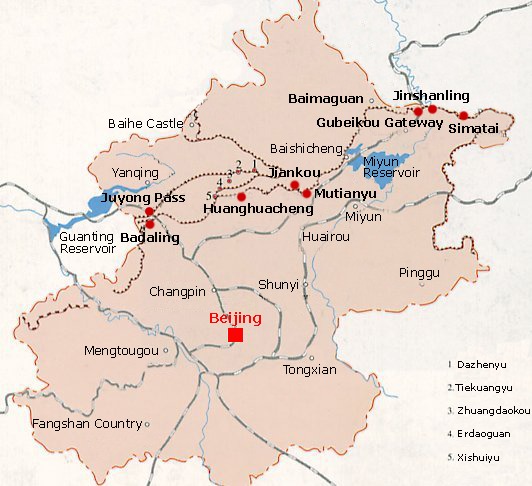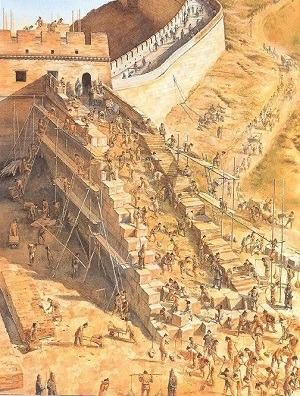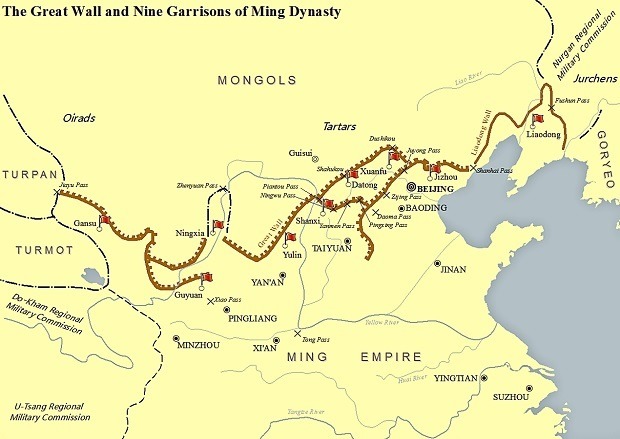
The Great Wall of China (长城 in Chinese) is a defense system built to keep the Mongol tribes out of China. The Great Wall is the largest man-made monument ever built in the world. It snakes 6400 kilometers or 4000 miles across northern China. It is a so huge project that many people lost their lives during the construction. The Great Wall was first to built during the Spring and Autumn period (770–476). Later Emperor Qin Shi Huang, first emperor of China, united the country and ordered to rebuild and connect the different sections of the wall.
In Beijing, you can find the Great Wall wind up ans and down on the northern mountains of Beijing. When invaders come the soldiers who guard the Great Wall signal fires from the Wall to provide early warnings.
The most popular activities tourists engage in at the Great Wall is hiking along the wall and occasionally camping overnight. Many companies offer guided tours that include food, transportation and accommodations for those staying overnight.
Great Wall of China Map
Great Wall Facts
Where is the Great Wall of China located?
The Great Wall of China stretches over approximately 4,000 miles from Shanhaiguan (山海关) in the east to Lop Nur in the west. Simply put, the path of the Great Wall of China stretches from a seaport on China’s east coast to Xinjiang in China’s northwest and in between it passes through a variety of mountains, plateaus and deserts.
Who built the Great Wall of China?
The labor force used in the construction of the Great Wall of China was made up of three main groups: the soldiers, common people, and criminals. The soldiers were the primary workforce, while the criminals were forced into labor as punishment.
 How the Great Wall was Built?
How the Great Wall was Built?
The grand Great Wall was built with blood, sweat, and tears of ancient Chinese. Countless families were separated, and many workers died during the construction of the Great Wall.Materials: stone, soil, sand, brick.
The major material of the wall was constructed by hand, rope, cart and goat. Ancient people develop advanced construction techniques to move huge amount of materials to the mountain top to build the wall.
How long did it take to build the Great Wall of China?
The Great Wall of China was never built at one go. Initially, powerful regional kingdoms built their own walls, which were solely meant for their own defensive military requirements. The earliest known sections of the Great Wall of China were constructed in the 7th century BC. After the emergence of unified China in the Qin Dynasty (221-206 BC), the Great Wall of China became a collective entity. Around 1700 years after this the Great Wall of China was enlarged and enhanced.
What is the length of the Great Wall of China?
The Great Wall of China stretches over approximately 6,400 km across a variety of terrains like mountains, plateaus and desserts.
What is the width of the Great Wall of China?
The width of the Great Wall of China is different at various positions and it ranges from 4.5 m to 9 m.
What is the height of the Great Wall of China?
The Great Wall of China has an average height of about 7.8 m.
What is the purpose of building Great Wall of China?
The Great Wall of China was built to serve as means to provide the armies a swift warning system and to create an elevated military roadway through the rugged terrain. Owing to the differences between agricultural and nomadic economies in China, the Great Wall provided a protection to the economic development and cultural progress to central China. The Great Wall of China also safeguarded the trade routes such as the Silk Road, and facilitated safe transmission of information and transportation.
What is the Great Wall of China made of ?
In the nascent stages the Great Wall of China was mainly built from earth, stones and wood. The use of bricks was a later development. Owing to the enormous amount of quantities of raw materials required to construct the Great Wall of China, the builders usually used materials that were available easily. For example while building over the mountain ranges, the stones of the mountain were used; while in the plains earth was pounded into solid blocks to be used in construction, whereas inn the deserts, the sanded reeds and juniper tamarisks were put to use.
The Great Wall of China Travel Tips

The most popular sites can be visited in one day starting from Beijing.
Badaling Great Wall (八达岭长城) and Juyongguan Great Wall (居庸关长城) are nearest Beijing, most crowded and touristy and these two sections have been heavily rebuilt to the extent that they had lost their original manner.
Mutianyu Great Wall (慕田峪长城) is also close to Beijing but slightly less crowded than Badaling. It has a cable car lift to get onto and off the wall and a wheeled toboggan ride down on a metal track. Fun though a bit misplaced. Alternatively, you can hike up a series of steps.
Huanghuacheng Great Wall (黄花城长城) is one of the most well built sections of the Great Wall.
Gubeikou Great Wall (古北口长城) , Jinshanling Great Wall(金山岭长城) and Simatai Great Wall (司马台长城) are a bit farther from Beijing than other sections, but the extra time it takes to get there is rewarded with a very significant reduction in crowding and tourist traps. Services are also limited, however; make sure you bring your own supply of water. The most authentic part of the wall is at Simatai; the wall here is of original construction unlike Badaling. These three locations are 140 km northeast of Beijing.
Jiankou Great Wall (箭扣长城) is a dangerous and wild Great Wall sections in Beijing. It is also a famous section by photographers for its precipitous mountains, unique construction style and attractive view.
The Best Time to Visit
The scenery of the Great Wall varies with the seasons, which offers many features and fodder for photographers who seek to obtain characteristic photographic works at any time of the year. However, if you are an ordinary visitor, the best times are spring and autumn, especially May, September or early October when it is usually sunny with brisk temperatures, leaving you more refreshed and comfortable.
Although it is hotter, June to August is an alternative, as the tourist season of the Great Wall is in full swing. November to April is always bitterly cold with biting winds, when the Great Wall encounters few, if any, tourists.
Clothing
The temperature variation between day and night along the Great Wall is obvious. We suggests a loose cotton T-shirt and a loose trousers rather than denim. However, if you go there in summer, wear shorts for daytime hiking and put on warm clothes such as jacket or sweater in the evening for you will feel somewhat cool, particularly in autumn. Good advice if you are to avoid catching cold.
Due to the steep inclines along the wall, trainers may be a good choice for shoes. Never wear high heels or you will quickly suffer from fatigue and in any event, they are hazardous in such locations. Anyway, make yourself as comfortable as possible.
Food and Drink
Your hike may last for 2-3 hours. Take some snacks along, while a good supply of water is necessary to avoid dehydration. These can be purchased on the Badaling Great Wall and Mutianyu Great Wall but at a possibly unexpected higher price. Remember, there are no sales on other sections of the Great Wall. However, do not drink too much water for there are no washrooms midway only those around the ticket office and the entrance.
Health and Safety
- Carry an umbrella to protect you from the sun as well as potential rainfall.
- Anoint yourself with some sunscreen and wear sunglasses to avoid the harm from strong ultraviolet radiation.
- As it is always dry in spring, autumn and winter, moisturizer may be helpful to moisturize your skin.
- It is quite windy in spring, autumn and winter, especially on the Great Wall due to its high altitude, so scarves can be warm and windproof to protect your face.
- Some sections of the wall are very steep but still can be manageable, use the handrail.
- Do not go to the Great Wall in bad weather (heavy rain, storm or thunderstorm), for there is no lightning rods on the beacon towers, and the stairways will be very slippery, which may put you in danger.
- Do not be bold to climb the undeveloped sections where the areas are insecure or damaged, or you may injured by the breakage of the wall.
- Carry some medicines such as remedies for cold, carsickness and some Band-Aids so that they are readily available should the need arise.
Other Tips
- Get up in the early morning at about 07:00 to catch the first official tourist bus to arrive at the Badaling Great Wall around 09:00-10:00 to avoid the large crowds of tourists, and thus you can get an early return to the city proper in the evening.
- For travel to Badaling Great Wall, you can also hire a taxi and have a round trip journey for about CNY500 according to the taxi type and your negotiation with the taxi driver. Or you may consider renting a comfort private car at CNY800
- Allow two to three hours for your visit the Great Wall.
- Cable cars are only available in Badaling, Mutianyu, Simatai and Jinshanling sections.
- You should be aware that noisy hawkers could be a problem on the Great wall.
- Learn more of the culture and history of the Great Wall before your hiking trip, to have a more informed experience.
- For protection of this world heritage, graffiti is not allowed on the Great Wall.
- Please leave no litter on the Great Wall, there are waste bins provided.
Transportation of Great Wall of China.
Please check our page How Far is the Great Wall from Beijing and How to Get There.
Great Wall of China admission fee and opening hours
For the admission fee, opening hours of different sections of Great Wall, please check our page List of Beiijing Tourist Attractions
Discover the Great Wall with Us
You can visit Great Wall in one day, we provide different affordable day trips to different sections of the Great Wall combined with other attractions such as Frobidden City, Ming Tombs.
Badaling Great Wall is magnificent and most popular among tourists:
Mutianyu Great Wall is more popular among foreigners:
- Mutianyu Great Wall and Ming Tomb (Changling Tomb) Tour – USD35
- Mutianyu Great Wall and Forbidden City Tour – USD40
- Mutianyu Great Wall Hiking Tour(Non shopping tour) – USD45
- Mutianyu Great Wall tour by bus – USD25
For other Great Wall hiking lovers :
All above tours include hotel pick up, shared air-con van, English speaking guide, entrance tickets and Chinese lunch.


